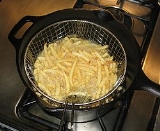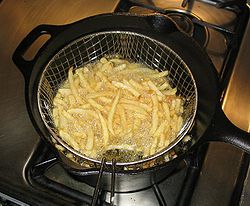
Chip pan
Encyclopedia

French fries
French fries , chips, fries, or French-fried potatoes are strips of deep-fried potato. North Americans tend to refer to any pieces of deep-fried potatoes as fries or French fries, while in the United Kingdom, Australia, Ireland and New Zealand, long, thinly cut slices of deep-fried potatoes are...
(called "French fries" in the USA) .
Today, they are made from either aluminium
Aluminium
Aluminium or aluminum is a silvery white member of the boron group of chemical elements. It has the symbol Al, and its atomic number is 13. It is not soluble in water under normal circumstances....
or stainless steel
Stainless steel
In metallurgy, stainless steel, also known as inox steel or inox from French "inoxydable", is defined as a steel alloy with a minimum of 10.5 or 11% chromium content by mass....
, although in the past were commonly made from cast iron
Cast iron
Cast iron is derived from pig iron, and while it usually refers to gray iron, it also identifies a large group of ferrous alloys which solidify with a eutectic. The color of a fractured surface can be used to identify an alloy. White cast iron is named after its white surface when fractured, due...
. A basket is placed inside the pan, to lower the chips into the hot cooking oil, and to raise them once cooked.
Chip pans are commonly used in the United Kingdom
United Kingdom
The United Kingdom of Great Britain and Northern IrelandIn the United Kingdom and Dependencies, other languages have been officially recognised as legitimate autochthonous languages under the European Charter for Regional or Minority Languages...
, although are slowly being outmoded by deep fryers.
Manufacture
Chip pans are commonly manufactured through a spinning process, as the metal used is malleable. The lid is typically stamped out by a dieDie (manufacturing)
A die is a specialized tool used in manufacturing industries to cut or shape material using a press. Like molds, dies are generally customized to the item they are used to create...
in a heavy press.
Health issues
Repeated heating of oil is believed to greatly increase the free radicals in the oil, leading to a higher risk of heart diseaseHeart disease
Heart disease, cardiac disease or cardiopathy is an umbrella term for a variety of diseases affecting the heart. , it is the leading cause of death in the United States, England, Canada and Wales, accounting for 25.4% of the total deaths in the United States.-Types:-Coronary heart disease:Coronary...
.
Oil burns
Injuries, particularly to children, caused by the hot oil from a chip pan falling on them are a common cause of hospital admission in the UK.Fire hazard

By comparison, electric deep fryers feature circuitry and design features (such as thermostat
Thermostat
A thermostat is the component of a control system which regulates the temperature of a system so that the system's temperature is maintained near a desired setpoint temperature. The thermostat does this by switching heating or cooling devices on or off, or regulating the flow of a heat transfer...
-controlled internal heating elements) that prevent the oil from being heated to the point of ignition. Boil-overs and splattering can still occur for the usual reasons, but the fire danger is largely eliminated.
Chip pans are the most common cause of house fire
Fire
Fire is the rapid oxidation of a material in the chemical process of combustion, releasing heat, light, and various reaction products. Slower oxidative processes like rusting or digestion are not included by this definition....
s in the United Kingdom, with around 12,000 chip pan fires every year, with 1,100 chip fires being considered serious. These fires result in over 4,600 injuries, and 50 deaths per year. British Fire Brigades frequently issue warnings and advice, urging households to switch to a safer means of cooking chips, and advising that unless the fire is easily contained to leave the fire to the emergency services.
Cooking oil fires (US class K, Europe class F) burn hotter than other typical combustible liquids, rendering the standard class B extinguisher ineffective. Class F fire extinguisher
Fire extinguisher
A fire extinguisher or extinguisher, flame entinguisher is an active fire protection device used to extinguish or control small fires, often in emergency situations...
s use saponification
Saponification
Saponification is a process that produces soap, usually from fats and lye. In technical terms, saponification involves base hydrolysis of triglycerides, which are esters of fatty acids, to form the sodium salt of a carboxylate. In addition to soap, such traditional saponification processes...
to put out chip pan fires by spraying an alkaline solution which reacts with the fat to make a non-flammable soap
Soap
In chemistry, soap is a salt of a fatty acid.IUPAC. "" Compendium of Chemical Terminology, 2nd ed. . Compiled by A. D. McNaught and A. Wilkinson. Blackwell Scientific Publications, Oxford . XML on-line corrected version: created by M. Nic, J. Jirat, B. Kosata; updates compiled by A. Jenkins. ISBN...
. However, these extinguishers are generally only available in industrial and commercial kitchens.
The dangers of oil or fat fires (generally flammable substances less dense
Density
The mass density or density of a material is defined as its mass per unit volume. The symbol most often used for density is ρ . In some cases , density is also defined as its weight per unit volume; although, this quantity is more properly called specific weight...
than water) are well known in industrial processes. Attempts to extinguish oil fires with water result in a boilover: an extremely hazardous condition whereby the flaming oil is violently expelled from the container. These fires result from either heating the oil to its autoignition point or by oil splattering onto the heat source.
External links
- Online copy of an Oxfordshire council safety flyer (PDF document)
- Photo story of a chip pan fire
- BBC News - A woman pulled from a chip pan fire thanks her rescuers
- North Yorkshire Fire Service - demonstration of a chip pan fire

